 USA – As named: USS Pennsylvania, West Virginia, California*, Colorado, Maryland and South Dakota.
USA – As named: USS Pennsylvania, West Virginia, California*, Colorado, Maryland and South Dakota.Renamed 1912 USS Pittsburgh, Huntington, Pueblo, Frederick, Huron: Active until 1927-31.
WW1 and prewar USN Cruisers
Atlanta class | USS Chicago | USS Newark | USS Charleston | USS Baltimore | USS Olympia | USS Philadelphia | USS San Francisco | Cincinatti class | Montgomery class | Columbia class | New Orleans class | Denver class | Chester class | Omaha classUSS New York | USS Brooklyn | Pennsylvania class | Saint Louis class | Tennessee class
The first 1900 Armoured cruisers serie:
The Spanish-American War showed the numerical inferiority of the US Navy and triggered a wave of new constructions, including new classes of armoured cruisers. Ordered in fiscal years 1900 (ACR-4/6) and 1901 (ACR-7/9) and succeeding Tennessee-class ships they were called the “Big Ten”. Intended to operate in the battle line with battleships. However her role changed after entering service.
Their names were initially USS Pennsylvania, West Virginia, California, Colorado, Maryland and South Dakota, later after cities with naming policy changes with new dreadnoughts being given state names. One even took part in the birth of US naval aviation. Their WWI career is a bit forgotten today, but they played their part. They remained active in the interwar, sold for BU after tonnage reductions imposed by the 1930 London Treaty. Rewritten and expanded article (2016-2025).
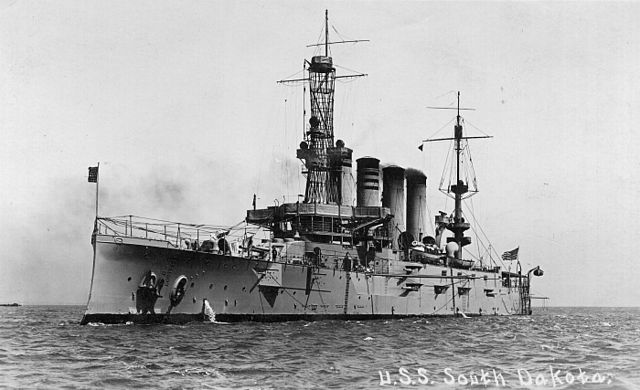
USS South Dakota 1915, notice the cage mast
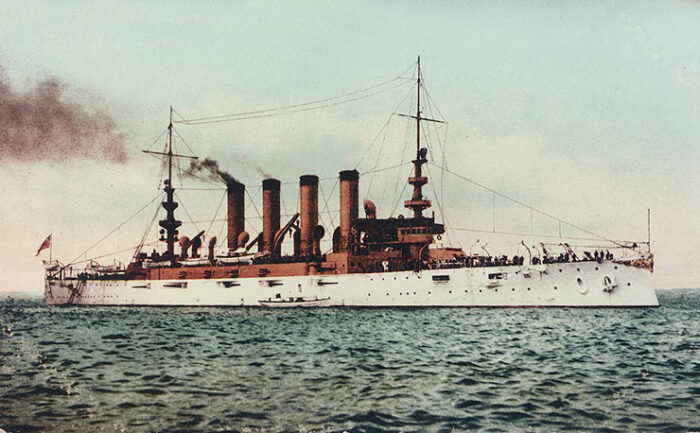
Development
The Pennsylvania class cruisers were a product of the Hispano-American war of 1898. There, three armoured cruisers had a special place: USS Maine by blowing up in Havana and triggered the war later in the first place, then the recent USS New York and USS Brooklyn. They confirmed some aspects, infirmed others, but led to think speed was essential in operation.
The Pennsylvania class were a brand new league in terms of armoured cruisers. They were properly massive, given their initial role, compared to the previous single ships of the 1898 war: USS New York (later Saratoga) and Brooklyn. These latter armoured cruisers were the first (after the very early USS Maine, ACR-1) to enter service, and they dated back well before the 1898 war: New York (ACR-2) was completed in 1893 and Brooklyn (ACR-3) in 1896 so a gap of three years to “digest” the previous design. She was ordered as an improved New York, 1,000t heavier and improved in many ways, she was also the only one inspired by French designs with a tumblehome, thick military masts and heavy turrets in a lozenge pattern, among others.
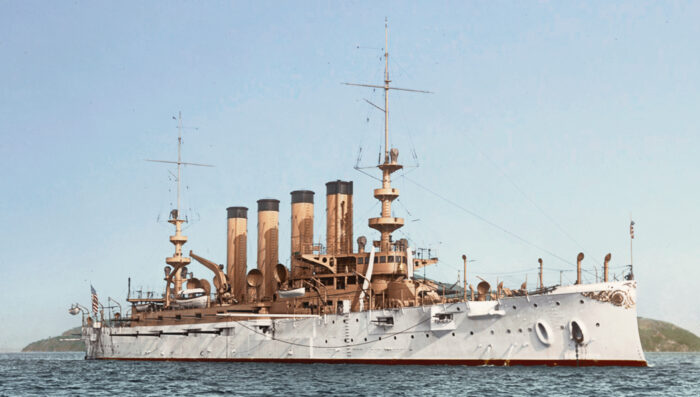
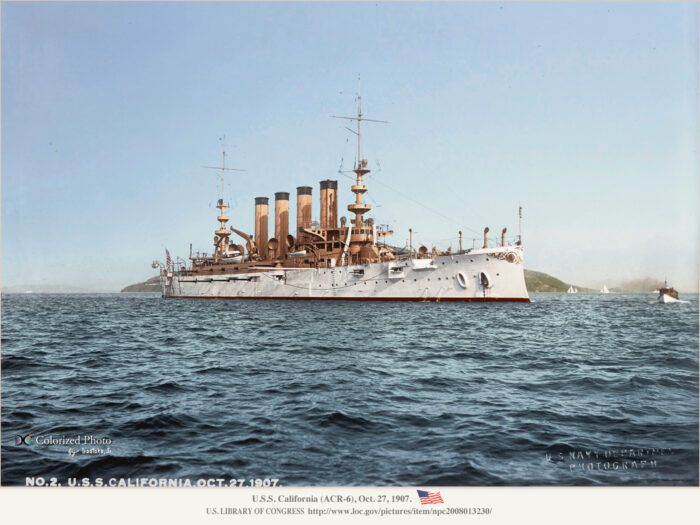
USS California in 1908 colorized by irootoko Jr
But for the next design, the Board had 1899 and 1901 and decide for a new cruiser design. These ships, authorized under the Acts of 3.3.1899 (first three) and 7.6.1900 (second three) were much larger than the two previous US armoured cruisers, and for many at the time, undergunned for their large size. They had been ordered in 1900, laid down in 1901 at William Cramp & Sons, Philadelphia as well at Newport News Shipbuilding, Newport News, Virginia (two each) on the East Coast, but also at Union Iron Works in San Francisco, West Coast. There had been launched 1903-1904 and entered service by 1905-1908, after alterations resulting of the Russo-Japanese war:
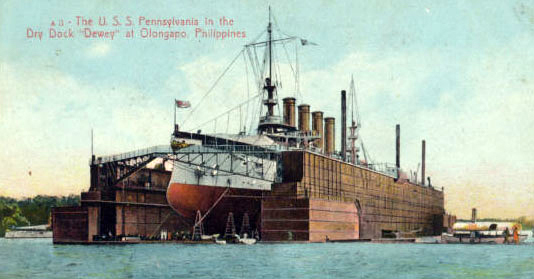
The 1904’s report Navy’s Bureau of Navigation looked at the most recent reports of the Russo-Japanese War, and concluded that armoured cruisers could be used as auxiliaries to battleships, taking place in the battle line if needed in a Mahanian decisive battle, although not replacing them in peacetime. Since most battleships were concentrated in the Atlantic, these new cruisers were planned to be assigned to the Asiatic Fleet in the Philippines in order to counter Japan’s rising naval power. Captain Sigsbee, as part of the discussion with the board, argued for adequate armour protection at the cost of speed.
The 1904 report of the Navy’s Bureau of Navigation it was declared that
“…the work of the armoured cruisers was auxiliary to that of the battleships…” and “They can serve with battleships, but they can never take their place”.
This, in 1906 it was decided to concentrate Battleships on the Atlantic Coast. Since they were no longer able to measure up to the latest dreadnoughts, it was decided of a new affectation, leaving Cruisers to deal with the possible Japanese threat on the Philippines, and it was decided to send these “substitutes for battleships” to the Asiatic Squadron. They were, by tonnage, speed and armament, believed to be enough of a deterrent to the confident Japanese Navy, now reinforced by scores of former Russian captured battleships and cruisers.
Design of the Pittsburgh class
Hull and general design
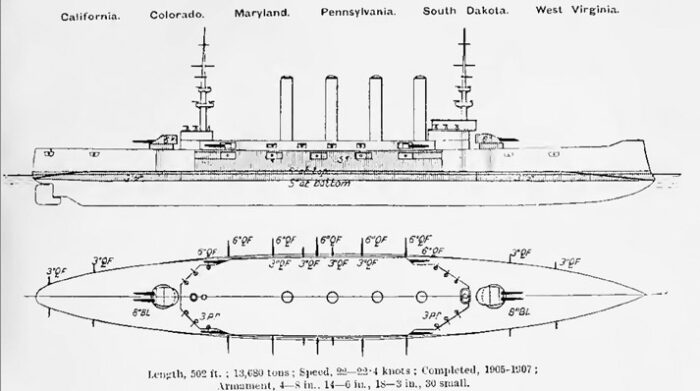
Brasseys annual depiction of the ships
The final design was much more impressive than the New York-Brooklyn, which were already closing on 10,000 tonnes. It was believed that more speed was necessary, and the hull was essentially stretched to accommodate a large powerplant. This resulted in a hull going from 402 ft 7 in (122.71 m)oa on Brooklyn, to 504 ft (153.6 m), so a 100 ft(30m) increase. The beam was kept close to the former designs at 69 ft 6 in (21.2 m) -versus 64 ft 8 in (19.71 m) on Brooklyn, not to compromise stability and resulting in a better length-width ration well suited to exploit the added output.
Draft was also superior at 26 ft 1 in (7.95 m) versus 24 ft (7.3 m) (mean). But given their lower profile, they had a better metacentric height. All this resulted in a massive, unprecedented tonnage for a cruiser in US history: 13,680 long tons (13,900 t) standard and 15,138 long tons (15,381 t) full load. To put things in perspective, this was comparable to the WW2 Baltimore class heavy cruisers, built 40 years later…
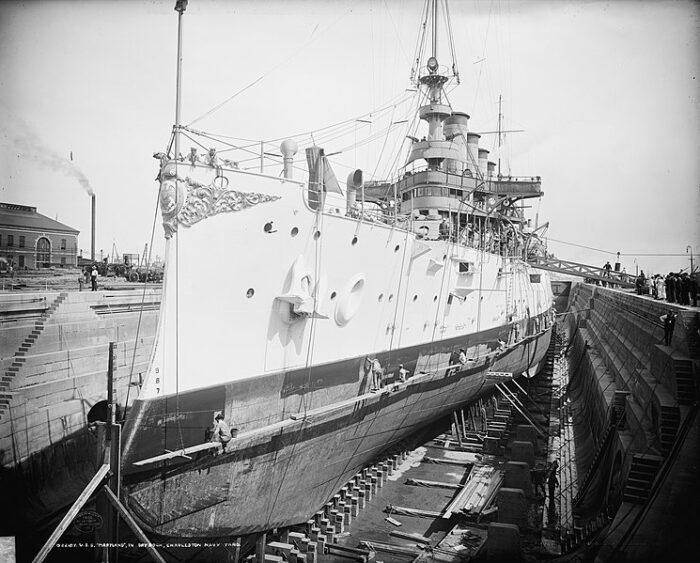
Powerplant
Propulsion was assured by two inverted vertical four-cylinder triple-expansion engines (IVTE) fed by 16 coal-fired Babcock & Wilcox boilers (ACR5, 6, 8, 9), but 32 Niclausse on Pennsylvania and Colorado (ACR4, 7) according to their respective builder’s preferences. These were rated for 250 psi (1,700 kPa) for a total of 23,000 ihp (17,000 kW) for 22 knots (41 km/h; 25 mph). On trials South Dakota achieved 22.24 kn (41.19 km/h; 25.59 mph) out of at 28,543 ihp. Coal storage was originally 900 tons, but could be increased to 2,000 tons by using void spaces. Again, this figure varied between ships, ACR4 and 7 carrying up to 1980t, ACR5 and 8 1850t, ACR6 and 9 2075t for an endurance of 5000nmm at 10 kts. This was not much superior to the previous USS Brooklyn which managed 21.9 knots on trials based on 16,000 ihp.
Protection
Krupp and Harvey steel.
These ships had a main belt protecting only the machinery amidship, with an upper battery belt with a thickness of 5 inches or 127mm, and a main belt of 6 inches or 152mm at the waterline.
The armoured deck over citadel was 1.5 inches or 38mm behind the belt with its flat section connected with lower belt edge by 4 inches or 102mm slopes. At its end the turtle back ended in a spindle with 4-in flat and 4-in slopes.
The Barbettes and ammunition wells were protected by 3 inches or 76mm. The upper part exposed to fire was 6 inches or 152mm thick.
The main guns turrets foe and aft were protected from 6.5 to 6 inches (165-152mm) for the front and sides, plus 1.5 inches or 38mm crowns.
The secondary casemated guns were protected by 5 inches or 127mm.
So in short:
Belt armor: 6 in (152 mm) waterline
Upper (battery) belt: 5 in (127 mm)
Main Turrets: 6.5 in (165 mm) face, 6 in roof.
Protective deck: 4-in sloped (102 mm) and 1.5 in (38 mm) on the flat section.
Conning tower: 9-in (229 mm) walls.
Armament
The Pennsylvania class originally were armed with four 8-inch (203 mm)/40 caliber Mark 5 guns (twin turrets fore and aft). The layout was kept, but the guns were modernized over time twice, and the secondary battery thrice. The main guns were indeed replaced in 1911 with 45 caliber Mark 6 guns, a result of a gun bursting on USS Colorado in 1907.
This was completed by fourteen 6-inch (152 mm)/50 caliber Mark 6 in side casemates.
The Light armament included eighteen 3-inch (76 mm)/50 caliber QF guns, twelve 3-pounder (47 mm (1.9 in)). Outside the 1-pounder (37 mm (1.5 in)) saluting guns, there were two 18-inch (457 mm) submarine torpedo tubes.
8-in/42 Mark V
The Mark 5 was a new 40 caliber design for armored cruisers and battleship secondaries. It was made of a tube, jacket, three hoops, one locking ring and muzzle bell. But it proved unable to handle the transition from black powder to nitrocellulose propellants, which burned more slowly with pressure buildups to unsafe levels as the shell progressed through the bore. On USS Colorado one blew off in gunnery practice off Yantai (Shandong) on 22 June 1907 and subsequently all Mark 5 guns were removed from service by 1908, lengthened to 45 caliber (new liner) re-hooped to the muzzle, becoming Mod 1, and placed into reserve. Two were tested with a new breech mechanism and gas seat as Mod 2. The Pennsylvania-class cruisers were thus all rearmed with the 8-inches/45 caliber Mark 6.
Specs:
40,151 lb (18,212 kg) without breech/40,621 lb (18,425 kg) with breech
Barrel 27 ft 10 in (8.48 m) bore (40 caliber)
−4° to +13°, 2.8 rounds per minute, 2,500 ft/s (760 m/s)
6-in/49 Mk VI/VIII
The secondary 6 inches Mark 6 in casemate was constructed of gun steel using a tube, jacket, four hoops, locking ring and Welin breech block. Calculations of the pressure curve of the charge and strength curve of the barrel met at the point of the barrel which was reinforced. Muzzle velocity was reduced from 2,800 ft/s (850 m/s) to 2,600 ft/s (790 m/s) and in Mod 1, nickel-steel was used for the tube, with two hoops and the locking ring, and one to the muzzle, returning to the original muzzle velocity. The Mod 2 were Mod 0s with a hoop to the chase and a new cylindrical liner in nickel-steel and retaining the same muzzle velocity. Later in life, all these cruisers had them replaced by the Mark 8.
Specs:
Mass: 18,112 lb (8,215 kg) without breech, 18,628 lb (8,450 kg) with breech.
Length 300.2 in (7,630 mm), Barrel length 294 in (7,500 mm)/49
Shell: 105 lb (48 kg) naval armor-piercing 6 in (152 mm)
−10° to +15°/−100° to +100°
Rate of fire: 6 rounds per minute, muzzle velocity 2,800 ft/s (850 m/s)
Effective firing range: 15,000 yd (14,000 m) at 14.9° WWI charge.
3-in/50 Mk III/V/VI
The first ring of defensife quick-fuiring light artillery were dependable, low-angle 3 inch/50-caliber guns (Marks 3, later 5, and then 6). Whatever the versions they fired the same unitary round capable of a muzzle velocity of 2,700-foot-per-second (820 m/s) making these udeal dual-purpose guns. Range was however limited at a maximum elevation of the mounting on the Mark 3 in particular. They had built-up guns with A tube and partial-length jacket, hoop and vertical sliding breech block.
Specs:
2,086 pounds (946 kg) with breech, 153.8 inches (3.91 m), Barrel 150 inches (380 cm) bore/50
Shell: complete round: 24 lb (11 kg); weight: 13 lb (5.9 kg) AP, AA, HE, Illum.
Elevation, Pedestal Mount: -10° to +15°/-10° to +85°, traverse 360°
Rate of fire: 15–20 rounds per minute
Muzzle velocity 2,700 ft/s (820 m/s)
Range 14,600 yd (13,400 m) at 43° elevation
3-pdr (47mm)/40-45 Driggs-Schroeder Mk I/II
Hotchkiss model built in the US, with a rotating barrel for the multitubes. In that case, these were all single barrel. First designed in 1885. These guns were considered by 1911 too small to be effective against torpedo carrying craft and withdrawn, replaced before WW1.
Specs:
Gun Weight 528 lbs. (240 kg), length oa 98.9 in (2.512 m), bore 74.1 in (1.881 m), 20 grooves.
Chamber vol. 45.8 in3 (0.751 dm3). Rate of fire 20 to 25 rounds per minute.
Round: Common complete Mark 4 Mod 1 6.7 lbs. 21.4 in (54.2 cm)
Muzzle Velocity 2,026 fps (618 mps) 40 cal., 2,119 fps (646 mps) 45 cal.
Elevation +50 degrees, range 6,500 yards (5,944 m) max.
1-pdr (37mm)/40 Driggs-Schroeder heavy Mk I
Two 1-pounder (37 mm (1.5 in)) RF guns, 50 caliber, Driggs-Schroeder “heavy long” Mk II, likely in the bridge’s wings. Used as saluting guns and removed in 1911.
Specs:
Fixed, 1.62 lbs. (0.7 kg) round, HE: 1.058 lbs. (0.48 kg), Common Mark 2 Mods 0/1: 1.088 lbs. (0.49 kg).
Common Mark 2: 0.026 lbs. (0.012 kg) Black Powder, 3.56 in (9.0 cm)
Cartridge Case: Brass, 37 x 137 mm, 0.406 lbs. (0.18 kg).
Propellant Charge: 0.15 lbs. (0.070 kg) NC, mv 1,500 fps (457 mps)
Heavy guns 2,000 fps (610 mps).
18-in(450)mm TT (beam)
They had “only” two broadside tubes likely for the Mark 4 Bliss-Leavitt (1908).
Diameter: 17.72 in (450 mm), length 197 in (5,000 mm), Weight 1,500 lb (680 kg) powered by a Vertical Turbine to c35 knots and Mk 1 contact exploder, straight course with gyroscope. Only 100 were made. In 1911 they were likely replaced by the common Mark 6.
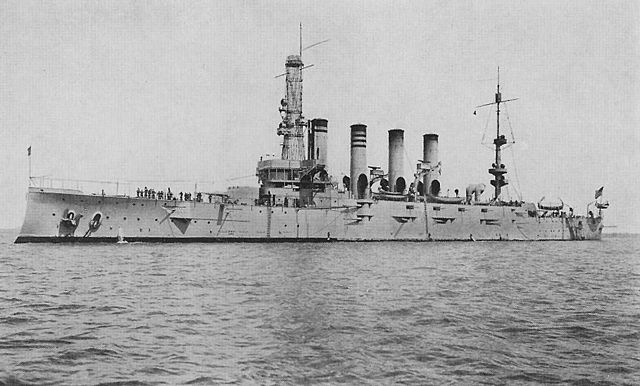
USS Huntington (Former Pennsylvania)

Illustration of the USS Pittsburgh in 1915.
⚙ Pittsburgh specs. |
|
| Displacement | 13,680 long tons (13,900 t) standard, 15,138 long tons (15,381 t) full load |
| Dimensions | 504 ft x 69 ft 6 x 26 ft 1 in (153.6 x 21.2 x 7.95 m) |
| Propulsion | 2 shafts VTE engines, 16 × Babcock & Wilcox* boilers: 23,000 ihp (17,000 kW) |
| Speed | 22 kn (41 km/h; 25 mph) |
| Range | 5000 nm/10 kts |
| Armament** | 4× 8 in/40 Mk 5, 14x 6 in/50 Mk 6, 18× 3 in/50, 12 × 3-pdr, 2× 1-pdr, 2× 18 in TTs |
| Protection | Belt 6–5 in, Turrets 6.5 in, Deck 4 in slope 1.5 in flat, CT 9 in |
| Crew | 830 |
*32 × Niclausse boilers in Pennsylvania and Colorado
**2×2 8 in/45 Mk 6, 4×6 in/50 Mark 6, 10× 3 in/50, 2× 3 in/50 AA.
Modifications
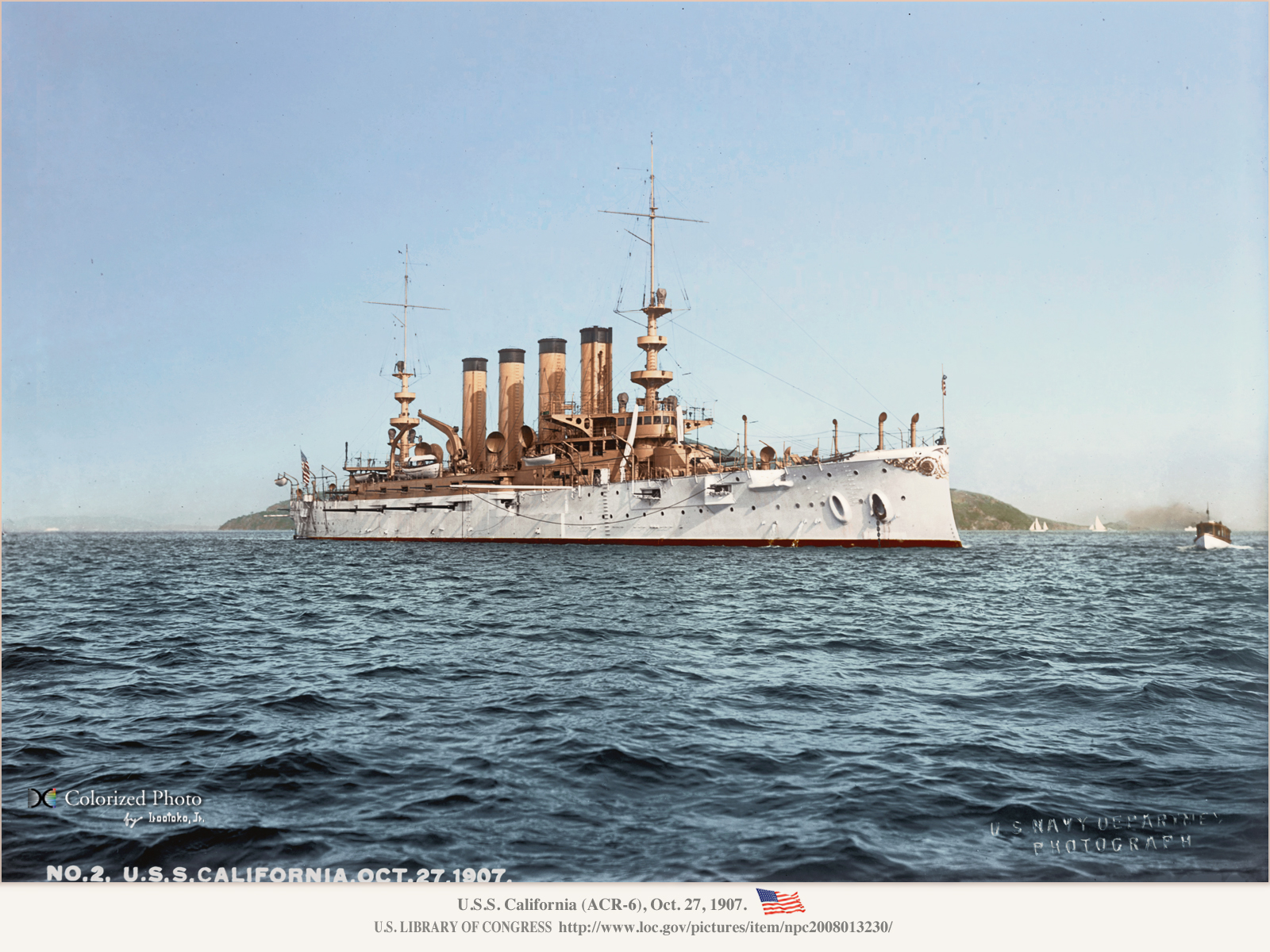
USS California in 1907, long before being renamed. Colorized by Irootoko Jr.
Chronology:
From 1909 to 1911 the 8-in/42 were replaced by the 45 cal. Mk VI in Mark 12 turrets, and cage foremasts installed.
From 1914 to 1919, USS Pittsburgh saw the removal of six casemated guns and most her 3-in/50 for the installation of two 3-in/52 Mk X and 16 Babcock & Wilcox boilers (as USS Pueblo). USS Huntington, San Diego, Frederick, and Huron saw the removal of all ten 6-in/50 and from six to eight 3-in/50 for the installation of two 3-in/52 Mk X.
1917: USS Huntington had a temprary catapult and decks for 4 airplanes plus gear for a balloon
1922: USS Pittsburgh had 4 boilers a funnel removed.
Air Group
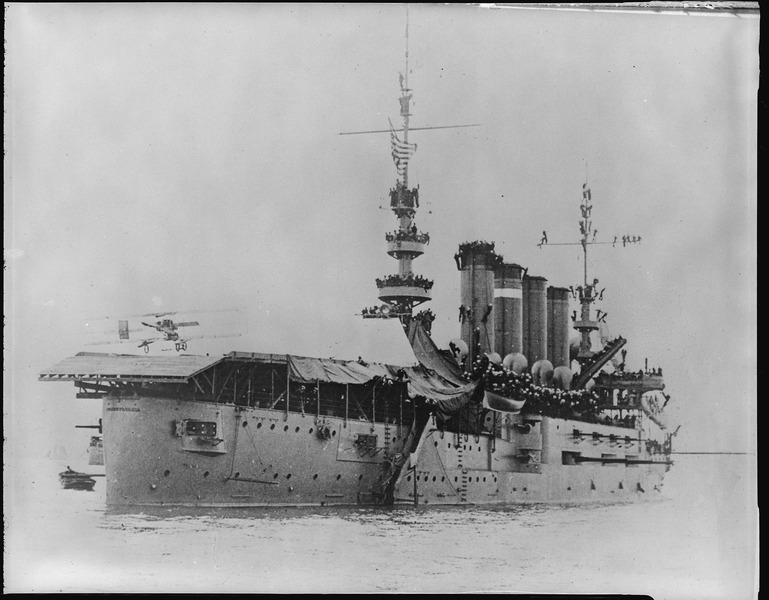
Eugen Ely landing on USS Pennsylvania (later USS Pittsburg)
–USS Pennsylvania was given an aft flight deck, used on 18 January 1911 by pilot Eugene Ely (second takeoff from a ship) from a 130-by-32-foot (39.6 by 9.8 m) platform. After landing, the very light aircraft was just returned in the right direction for taking off from the same. The crew retained, and then drop it while at full throttle, she dropped slightly and had enough air to get lifted immediately after.
–USS Huntington from 1915 to April 1917 had a catapult for seaplanes installed on the after turret, carrying up to four aircraft, and an observation balloon for convoy escort duty. They were removed by late 1917. The seaplanes were Martin model
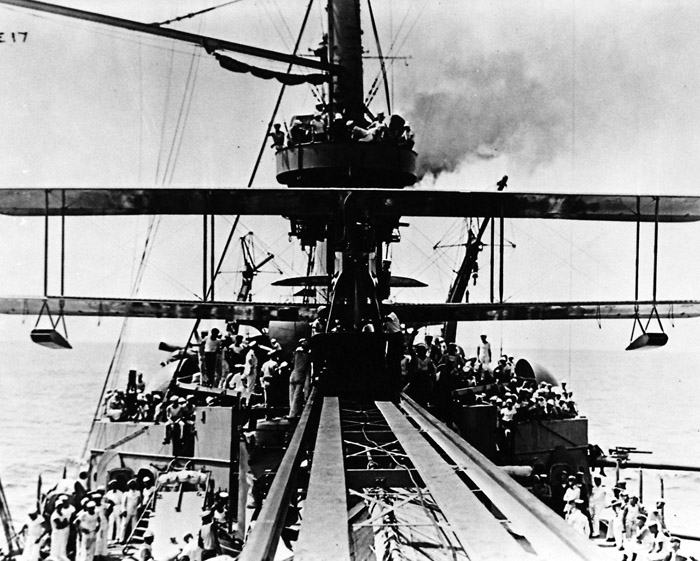
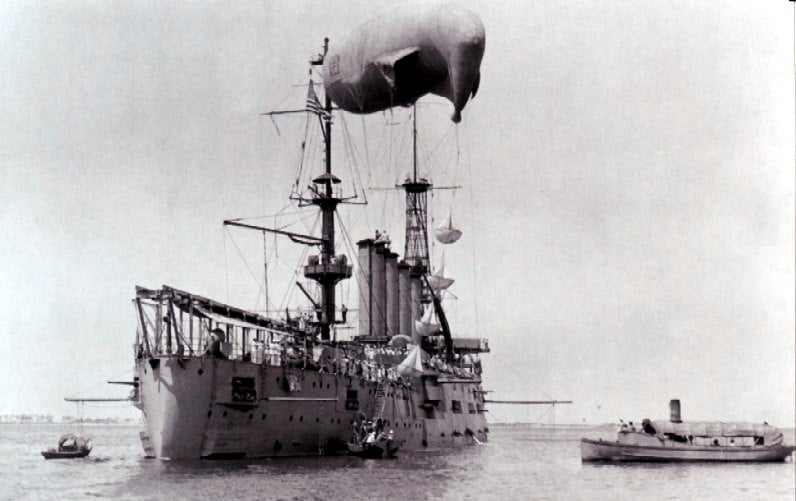
USS Huntington’s reconnaissance Balloon trials, Pensacola FL, 1917.
Evaluation
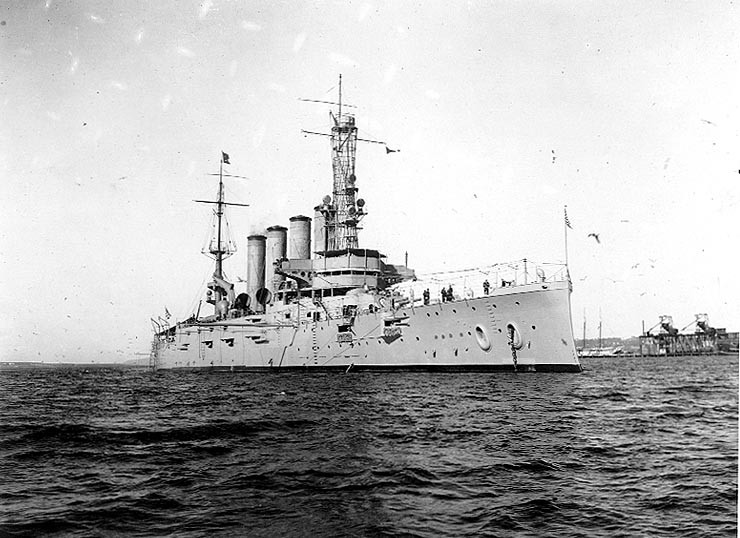
USS San Diego, ex-California January 1915.
The Pennsylvania class spent the years prior to 1917 patrolling Latin America and the Western Pacific. Colorado landed troops in a 1912 intervention in Nicaragua. In early 1917, the ships operated in the South Atlantic and the Pacific, and transferred to convoy escort duty in the North Atlantic. USS
USS Pittsburgh remained in the Pacific, to search for German commerce raiders. The first Medal of Honor was awarded to shipfitter Patrick McGunigal for rescuing a balloon pilot. USS San Diego was sunk on 19 July 1918, (mine) off Fire Island, New York.
The six ships were rechristened between 1912 and 1920 Pittsburgh, Huntington, San Diego, Pueblo, Frederick, and Huron, notably to leave these names to the new Dreadnoughts in construction.
Most ships were decommissioned or relegated as “receiving ship” in the early 1920s; Pittsburgh and Huron continued on to 1930. All were sold for scrap in 1930-1931 (London Naval Treaty tonnage limits). Huron was converted as a floating breakwater in Powell River, British Columbia (lost in a storm 1961).
Active career
 USS Pennsylvania ACR-4 (Pittsburg)
USS Pennsylvania ACR-4 (Pittsburg)

USS Pennsylvania was ordered and laid down at William Cramp & Sons in Philadelphia on 7 August 1901. She was launched 22 August 1903, and commissioned on 9 March 1905 with Captain Thomas C. McLean in command. She operated on the East Coast/Caribbean Sea until 8 September 1906. She then left Newport for the Asiatic Station, back to San Francisco on 27 September 1907 (west coast duty), stopping in Chile and Peru in 1910.
At 10:48, on 18 January 1911, Eugene Ely, flew a Curtiss Model D from Tanforan Racetrack in San Bruno, and landed on her flight deck at 11:01 while off anchor in Hunters Point, San Francisco Bay. It was a smooth landing from astern taking off again at 11:58, back to Selfridge Field, an historic first. Glenn Curtiss later taxied a hydroairplane in San Diego on 17 February 1911 and at 08:45 it was craned up onboard by sailors, returned to base.
She was placed in reserve at Puget Sound (July 1911 – May 1913), training naval militia, and renamed Pittsburgh on 27 August 1912. In 1914 she patrol off the coast of Mexico during the revolution and Veracruz landing by April 1914. She became flagship for Admiral William B. Caperton, C.i.C. Pacific Fleet. Later still before 1917 she operated with the British scouting for potential German raiders, a deterrent in the eastern Pacific.
She had 58 sailors which died on board by the 1918 influenza outbreak. It happened at Rio de Janeiro in October-November 1918, with the failure to implement quarantine procedures by Captain George Bradshaw. In all, 663 sailors were hit.
In the Inter-war she was back to the east coast as flagship, CiC eastern Mediterranean. She departed Portsmouth on 19 June 1919 for the Adriatic Sea, Aegean Sea, and Black Sea, joining a relief operation in Crimea. In June 1920 she visited French and British ports, cruised the Baltic Sea. On 9 September 1920 she ran aground on rocks off Libau. She was freed, assisted by HMS Dauntless and Frederick, repaired at Sheerness in Kent from 23 September, then Chatham dry dock. A court-martial absolved Captain Todd of blame, but not the navigator and watch officer. She was back to be decommissioned at Philadelphia, on 15 October 1921 until 2 October 1922. She returned in Europe as flagship via Gibraltar (19 October).
On the 23rd she hosted Vice Admiral Long, relieving USS Utah. By 10 July 1923, she was in Cherbourg, France landing her Marine Detachment for the inauguration of the Belleau Wood National Monument. In 1923, she was docked in Amsterdam, the crew made discover baseball to Dutch players. She was flagship next for Admiral Philip Andrews (1924–1925) Vice Admiral Roger Welles (1925–1926). Back in New York on 17 July 1926, she was prepared for the Asiatic Fleet, refitted, and sailed on 16 October for Yantai (23 December).
In January 1927, she landed sailors and Marines in Shanghai until Chiang Kai-shek’s National Revolutionary Army took control. In March, she was back in exercises and carried the Governor General of the Philippines, Dwight F. Davis to Saigon, Bangkok, Singapore, Belawan, Batavia, Surabaya, Bali, Makassar, and Sandakan, back to Manila on 15 April 1931. She headed for Suez, Hampton Roads (26 June) to be decommissioned on 10 July (London Naval Treaty), sold for BU 21 December.
 USS West Virginia ACR-5 (Huntington)
USS West Virginia ACR-5 (Huntington)
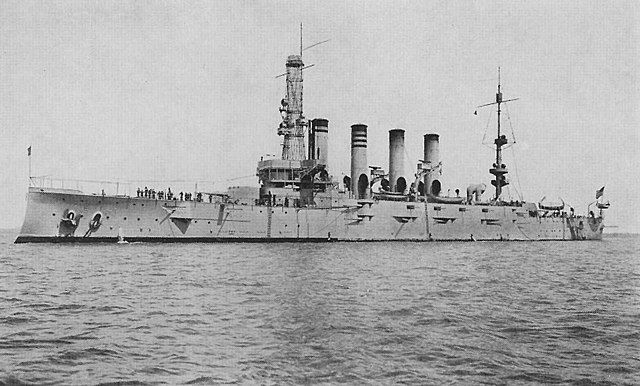
USS West Virginia was ordered at Newport News Shipbuilding, Newport News, Virginia on 16 September 1901, launched 18 April 1903, 23 February 1905 Captain C. H. Arnold in command. After shakedown training, she cruised with the New York Naval Militia, Atlantic Fleet until 30 September 1906 and departed for the Asiatic Fleet, remaining in the First Squadron for two years before an overhaul at Mare Island (1908) and back. In 1911–1912 she was in Hawaiian waters. In 1914, she was on “special duty” off the west coast of Mexico. Next she was at Bremerton, Pacific Reserve Fleet until 20 September 1916, then back to Mexico and renamed Huntington on 11 November. Next she was transformed at Mare Island with a catapult on the quarterdeck and four seaplanes.
Now as USS Huntington (ACR-5) she also tested a Kite balloon, in full commission on 5 April 1917 for tests at the Naval Air Station Pensacola. She left for Hampton Roads on 1 August, reached New York, escorting a convoy of six troopships for France, on 8 September, using balloon for ASW observation flights along the way. But she lost one on 17 September, forced down by a squall. Observer, Lt.(jg) Henry W. Hoyt fell from the basket, was caught underwater, entangled in rigging and saved by ship fitter Patrick McGunigal which jumped overboard (Medal of Honor). She was back to Hampton Roads on 30 September.
She saw in New York on 5 October her catapult and seaplanes removed and departed on 27 October to Halifax, and sail in the Atlantic with USS St. Louis on a high-level US Commission with the Allies, hosting Colonel Edward M. Housen, Admiral William S. Benson; General Tasker H. Bliss in Davenport UK on 7 November. She headed back to New York, arrived on 27 November.
Next she escorted nine convoys (19 February-13 November 1918) and three coastal convoy passages (New York-Hampton Roads). In fact, she was even converted as troop transport, partly disarmed, at Brooklyn Navy Yard from 17 November 1917 and made nine more trips as well as four short trips through the submarine zone off the US Atlantic Coast.
In the Interwar she was in the Cruiser and Transport Force (Atlantic Fleet) bringing back vets from France (New York-Brest-New York). In five voyages she carried 12,000 troops, the last to Boston on 5 July. Detached, reassigned to Cruiser Force, she became flagship of Flying Squadron 1 on 8 July 1919 but was decommissioned at Portsmouth on 1 September 1920, struck on 12 March 1930 after 10 years reserve, sold on 30 August.
 USS California ACR-6 (San Diego)
USS California ACR-6 (San Diego)
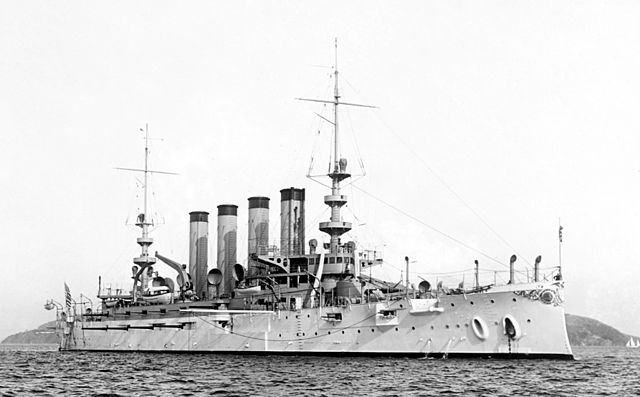
USS California in 1907
ACR-6 was laid down at Union Iron Works, San Francisco on 7 May 1902, launched on 28 April 1904 and completed on 1 August 1907. Se was assigned after shakedown to the 2nd Division, Pacific Fleet and took part in the Naval Review at San Francisco (May 1908) for SecNav Victor H. Metcalf. She cruised to Hawaii and Samoa late 1909, and west coast until December 1911. In March 1912 she was back at Honolulu, and the Philippines with the Asiatic Station, the back home in August 1912. Next she landed Marines and a party at Corinto, Nicaragua ad patrolled off Mexico. She took part there in a international incident in which two of her crew were shot and killed.
Renamed USS San Diego on 1 September 1914 she became flagship CiC Pacific Fleet intermittently. She had a boiler explosion in January, repaired at Mare Island until the summer of 1915. Ensign Robert Cary and Fireman Second Class Telesforo Trinidad both earned a Medal of Honor while containing damage. She became a popular attraction at the Panama–California Exposition. USS San Diego was flagship again from 12 February 1917, placed into reserve status. She was fully recommissioned on 7 April as flagship Cdr Patrol Force (Pacific Fleet) until 18 July. She joined the Atlantic Fleet at Hampton Roads by 4 August and Cruiser Division 2 (CruDiv 2), flagship Cdr Cruiser Force Atlantic until 19 September. She started escorting convoys from Tompkinsville, New York, and Halifax, Nova Scotia in the North Atlantic to Britain and back.
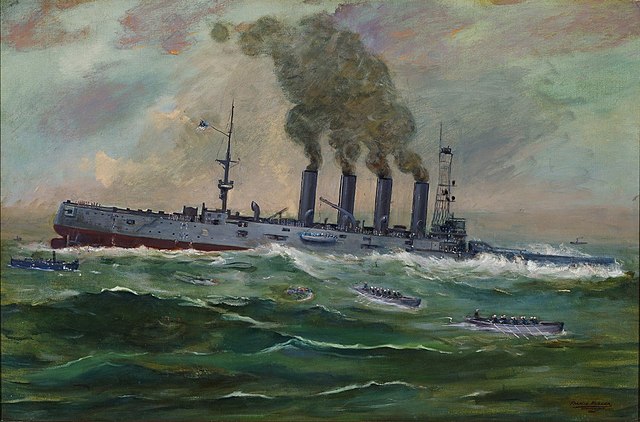
“The Sinking of USS San Diego”, by Francis Muller.
Early on 18 July 1918, she had left Portsmouth bound for New York where for another escort mission to France under captain Harley H. Christy. Being weary of possible U-Boats in the area, he ordered a zigzag course at 15 knots (28 km/h; 17 mph) in poor visibility under 6–8 mi (9.7–12.9 km). He would later report to the Board of Inquiry that all lookouts, gun watches, and fire control parties were on full alert and ready. At 11:05 on 19 July while underway NE of the Fire Island Lightship there was a detonation on her port side, close to her port engine room, well below the waterline.
The bulkhead was warped, the watertight door remain jammed open, and the flooding went quickly. Captain Christy assumed rightly she had been torpedoed and sounded submarine defense quarters, asking for full speed ahead, had right rudder, but was told she had lost all power. She took a 9° list and went by the bow until her forward gun deck was underwater, with more rushing through the deck hatches. Christy dispatched the gunnery officer to the mainland to help rescue vessels as he lost communication.
10 minutes after, the cruise was clearly sinking by the bow, and orders to abandon ship were given, with the crew scrambling around life rafts and boats. All was done in a disciplined and orderly manner. Christy was rescued himself by Ferdinando Pocaroba and the ships had disappeared after 28 minutes, taking only six lives (2 killed in the explosion, one fell, one was crushed by a funnel, one drawn, trapped inside). This was the only major US warship loss in World War I. The gunnery officer reached shore at Point O’ Woods in New York after a two-hour trip, and directed rescue.
The Navy Department was also informed of a German mine laying submarine there and the US Naval Air Service launched all Aircraft available, from the First Yale Unit (Bay Shore in Long Island). They found and attack San Diego then still sinking, believing it was the submarine. There was none on board.
Captain Christy was confronted by a court-martial, as there was no evidence of a U-boat in the area at the time, however mines had been found in the area. In August 1918, the Naval Court of Inquiry concluded that way, mentioning that six contact mines located in the vicinity of this spot.
By 2018 the exact sinking cause remains unknown, albeit its likely she had been sunk by mine planted by U-156 south of Long Island.
Her wreck is now laying under 110 ft (34 m) and is a popular shipwreck for scuba diving, albeit she had decayed a lot over the last century, gaining the nickname of “Lobster Hotel”.
 USS Colorado ACR-7 (Pueblo)
USS Colorado ACR-7 (Pueblo)
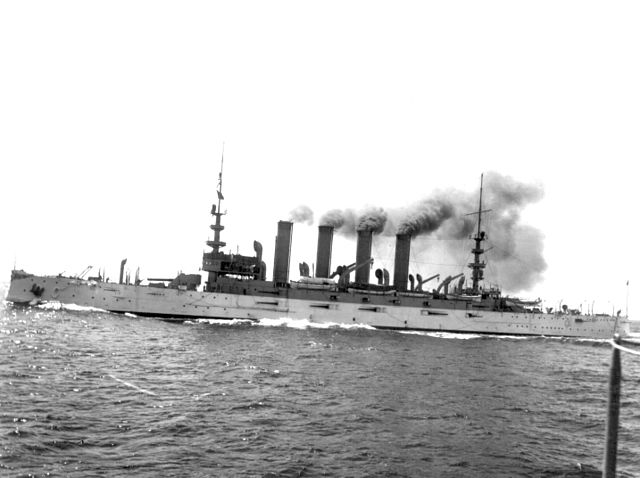
USS Colorado in 1907
ACR-7 was laid down at William Cramp & Sons, Philadelphia on 25 April 1901. She was launched on 25 April 1903 and commissioned on 19 January 1905 under command of captain Kennedy. She started her shakedown cruise on the East Coast to Target Bay in Culebra Island (Puerto Rico) from 24 March 1905. She was next in Division 4, Cruiser Squadron, Atlantic Fleet based in Provincetown, Massachusetts from 14 May. She was the first drydock in USS Dewey first USN steel floating dry dock near Solomons Island in Maryland (23-24 June 1905).
She took part in a fleet problem in the Caribbean (10 January–17 April 1906) when Captain Kennedy died while at sea, buried ashore at Guantánamo Bay, replaced by Lt. Cdr. Joseph L. Jayn from 12 April. She took part in the Presidential Naval Review in New York Oyster Bay 2–4 September. She then sailed for the Asiatic Station on 7 September via Japan and China and back to San Francisco on 27 September 1907 for a series of exercises on the west coast and South America. Furthermore, she ran aground on 15 August 1908, which led to improve the lighthouses in Puget Sound.
On 26 August 1909 she collided with the ferry City of Seattle in Seattle (minor damage). She was back in the Far East from September 1909 to February 1910 and from November 1911 to July 1912. In August to November she landed and supported expeditionary troops at Corinto, Nicaragua and patrolled Mexican waters. She was placed in reduced commission at Puget Sound from 17 May 1913, on full by 9 February 1915, now as flagship of the Pacific Reserve Fleet. She remained in Mexican waters and was in reserve from 26 September 1915, renamed USS Pueblo on 9 November 1916, in overhaul.
Likewise, she tried to assist the grounded Milwaukee trying to help USS H-3 in Humboldt Bay (California) at Eureka on 5 January 1917. But while doing this she was stranded in the first line of breakers at Samoa Beach crewmen reached shore safely. Pueblo was there on 24 January, but failed to salvage the stricken cruiser, which was decommissioned in March 1917. She was written off after a storm in November 1918 which broke her in two.
USS was flagship of the Scouting Force, South Atlantic in 1917 and back at Norfolk on 18 January 1918. From 5 February to 16 October, she made seven convoy escort missions to England. She carried the Brazilian ambassador to the US and back to Rio and made six more transatlantic voyages (Hoboken-Brest) with veterans of the American Expeditionary Force. In Philadelphia on 8 August 1919 she was now in reduced commission, fully decommissioned on 22 September, CA-7 in 1920, recommissioned on 2 April 1921–28 September 1927 as receiving ship, 3rd Naval District, stricken and sold on 2 October 1930.
 USS Maryland ACR-8 (Frederick)
USS Maryland ACR-8 (Frederick)
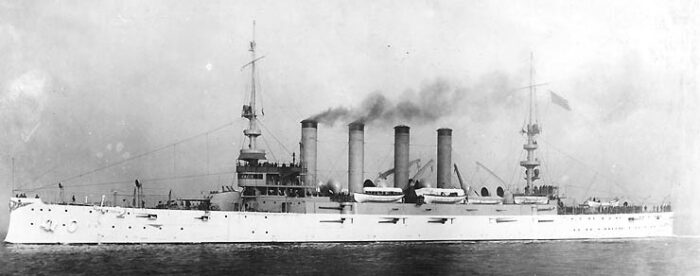
ACR-8 was laid down at Newport News Shipbuilding in Newport News (Virginia) on 29 October 1901, launched on 12 September 1903 and commissioned on 18 April 1905 under Captain Royal R. Ingersoll in command. In October 1905 she completed her shakedown and joined the Atlantic Fleet, east coast/Caribbean training. She wa sin the 1906 winter maneuvers off Cuba and had a training cruise for the Massachusetts Naval Militia.
She was prepared for the Pacific, departed Newport on 8 September 1906 via San Francisco and Hawaii for her station until October 1907. Back to San Francisco for the next 10 year she remained on the West Coast with forays in the Pacific (survey missions in Alaska 1912-1913) for example. She carried the US Secretary of State Knox to Tokyo for the funeral of Emperor Meiji in 1912, had relief missions on the Central American coast, Mexico-Nicaragua in 1913, 1914, and 1916, made training cruises to Hawaii and South-Central Pacific.
She received a practice torpedo from USS Grampus (SS-4) on August 24, 1912, to test her protection and later USS Pike (SS-6), in a simulated attack. The practice torpedo had an inert, collapsible warhead, but still punctured her hull 9 feet below the waterline. Flooding had her listing 5 degree. Thus was very useful to rethink ASW protection on ships of the new generation.
From 6 April 1917, now named USS Frederick since 9 November 1916 she was between Puget Sound and San Francisco. She took there men and supplies and headed for the Atlantic. From May 1917 to January 1918, she patrolled the southeastern Atlantic. On 1 February she was in escort duty, North Atlantic. After the Armistice, she convoyed troopships. By 20 November she joined the Cruiser and Destroyer Force. By mid-1919 she had completed six round trips with troops from France. She was in refit and reduced commission at the Philadelphia Navy Yard. Later she carried the US Olympic Team to Antwerp. Back home she carried naval reservist by July 1920. In 1921, she was used as setup for scenes in Harold Lloyd’s “A Sailor-Made Man”. She returned to the Pacific Fleet as flagship of the Train with a long cruise to South America by March 1921. On 14 February 1922 she decommissioned, Reserve Fleet at Mare Island until struck on 13 November 1929, sold for BU on 11 February 1930.
 USS South Dakota ACR-9 (Huron)
USS South Dakota ACR-9 (Huron)
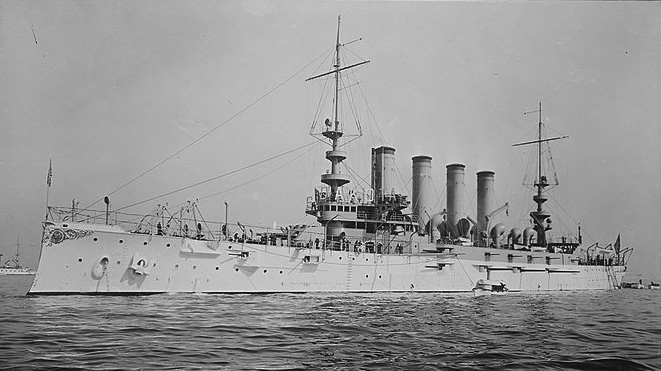
USS South Dakota (ACR-9) was authorized by the congress on 7 June 1900 with her hull and machinery cost were under a contract total of $3,750,000 at Union Iron Works in San Francisco. She was laid down on 30 September 1902 and launched on 21 July 1904, commissioned on 27 January 1908. Capt. Charles E. Fox reported on board as the ship’s General Inspector on 30 August 1907. She completed her preliminary acceptance trials on 19 November followed by a shakedown cruise from 3 March 1908 and started service in Mexican waters, Magdalena Bay and Isla Cedros before heading for San Diego on 13–24 March, San Pedro, Long Beach, San Pedro, Mare Island and San Francisco.
She completed her shakedown in the Pacific Northwest and Washington in 2 April 1908 before receiving fixes, dry-dock at Puget Sound and being assigned to the Armored Cruiser Squadron of the Pacific Fleet. Likewise, she left Seattle for Puget Sound and met the Atlantic Fleet in May for final acceptance trials off San Francisco. Furthermore, she departed at last with USS Tennessee on 24 August to Pago Pago, Samoa.
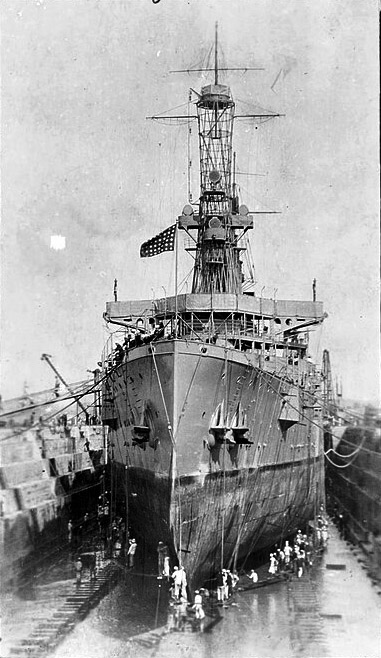
http://www.navsource.org/archives/04/acr9/acr9.htm
http://freepages.rootsweb.com/~cacunithistories/military/USS_South_Dakota.html
In 1909, she was back in Central and South American waters. Next, underway in the Pacific, she visited the Admiralty Islands, Philippines, Japan, China, and Hawaii back in 1910. She was part of the South American “Special Service Squadron” and was back to the Pacific in 1911, with cruises from Hawaii to the Marianas, Philippines and Japan, back to the west coast in August 1912 for exercises and on reserve from 30 December 1913 at Puget Sound.
She sailed for the Pacific Fleet on 17 April 1914 but after a tour in Mexican waters in May. Likewise, she was in Hawaii by August, back to Bremerton on 14 September, reserve on 28 September as flagship for the Pacific Fleet reserve from 21 January 1915 until relieved by USS Milwaukee on 5 February 1916 but still in reduced commission, reactivated on 5 April 1917, Atlantic fleet. She joined USS Pittsburgh, Pueblo, and Frederick at Colón, Panama on 29 May and patrolled the South Atlantic. On 2 November 1918, she escorted troop convoys from the East Coast to mid-Atlantic, relieved by British cruisers. After the Armistice she made two Brest-New York troops return voyages.
By the summer 1919 USS South Dakota returned to the Pacific as flagship, Asiatic Fleet, from Manila on 27 October. She was renamed USS Huron on 7 June 1920 (CA-9) and stayed there for seven years. In summer, she was at Shanghai and Yantai when not in Manila. On 25 February 1925 she ran aground off Palawayan Island, NL East Indies, refloated the next day. She left Manila on 31 December 1926 for Puget Sound (3 March 1927) to be decommissioned on 17 June, reserve until stricken on 15 November 1929, sold for BU 11 February 1930.
Read More/Src
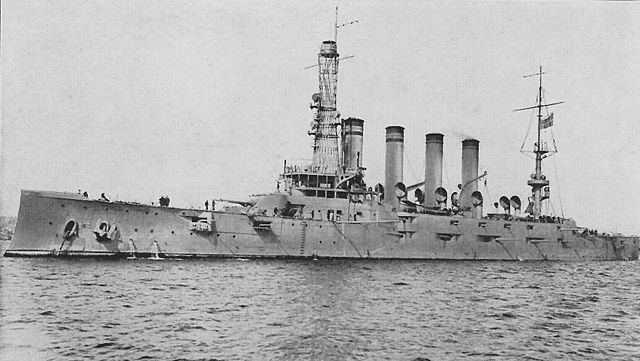
USS Frederick, ex-Maryland in 1918.
Books
Alden, John D. American Steel Navy: A Photographic History of the U.S. Navy from the Introduction of the Steel Hull in 1883 to the Cruise of the Great White Fleet
The Chatham News 1920-12-20 . 20 December 1920. Microfilmed copy available for consultation at Medway Archives
Friedman, Norman. U.S. Cruisers: An Illustrated Design History. Annapolis, Maryland: Naval Institute Press, 1984.
Musicant, Ivan. U.S. Armored Cruisers: A Design and Operational History. Annapolis, Maryland: Naval Institute Press, 1985.
Taylor, Michael J.H. (1990). Jane’s Fighting Ships of World War I. Studio.
Links
on navypedia.org
on history.navy.mil/
on hazegray.org/danfs/
on navsource.org/
archive.org/ fighting hunonuss
on navsource.org/
navweaps.com/ 3pounder mk1
web.archive.org findaid/
Ships Data, U. S. Naval Vessels, 1911 USN Dept.
on en.wikipedia.org Pennsylvania-class_cruiser
Gallery
Videos
https://archive.org/details/gov.archives.li.127-g-4812
Model Kits
USS South Dakota ACR-9 1:350 1906 by Iron Shipwrights
on modelshipmaster.com

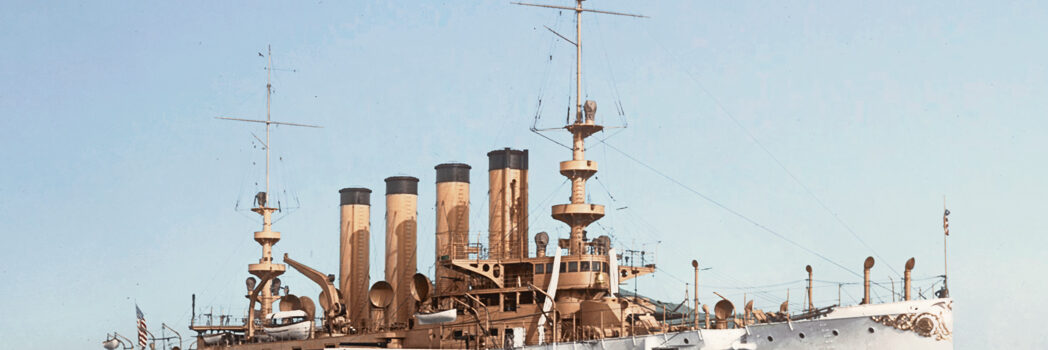
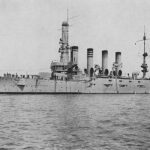

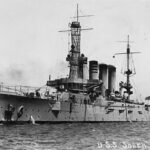

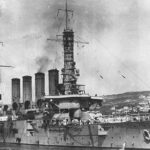
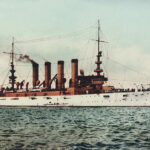
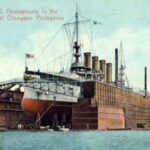
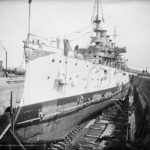
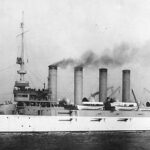

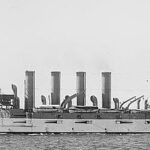
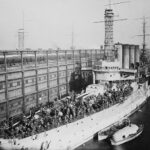

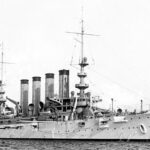
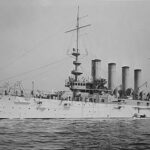
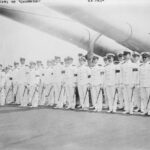
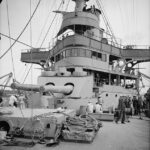
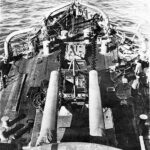
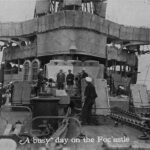
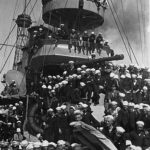

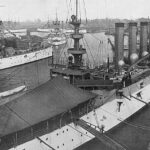
 Latest Facebook Entry -
Latest Facebook Entry -  X(Tweeter) Naval Encyclopedia's deck archive
X(Tweeter) Naval Encyclopedia's deck archive Instagram (@navalencyc)
Instagram (@navalencyc)





 French Navy
French Navy Royal Navy
Royal Navy Russian Navy
Russian Navy Armada Espanola
Armada Espanola Austrian Navy
Austrian Navy K.u.K. Kriegsmarine
K.u.K. Kriegsmarine Dansk Marine
Dansk Marine Nautiko Hellenon
Nautiko Hellenon Koninklije Marine 1870
Koninklije Marine 1870 Marinha do Brasil
Marinha do Brasil Osmanlı Donanması
Osmanlı Donanması Marina Do Peru
Marina Do Peru Marinha do Portugal
Marinha do Portugal Regia Marina 1870
Regia Marina 1870 Nihhon Kaigun 1870
Nihhon Kaigun 1870 Preußische Marine 1870
Preußische Marine 1870 Russkiy Flot 1870
Russkiy Flot 1870 Svenska marinen
Svenska marinen Søværnet
Søværnet Union Navy
Union Navy Confederate Navy
Confederate Navy Armada de Argentina
Armada de Argentina Imperial Chinese Navy
Imperial Chinese Navy Marinha do Portugal
Marinha do Portugal Mexico
Mexico Kaiserliche Marine
Kaiserliche Marine 1898 US Navy
1898 US Navy Sovietskiy Flot
Sovietskiy Flot Royal Canadian Navy
Royal Canadian Navy Royal Australian Navy
Royal Australian Navy RNZN Fleet
RNZN Fleet Chinese Navy 1937
Chinese Navy 1937 Kriegsmarine
Kriegsmarine Chilean Navy
Chilean Navy Danish Navy
Danish Navy Finnish Navy
Finnish Navy Hellenic Navy
Hellenic Navy Polish Navy
Polish Navy Romanian Navy
Romanian Navy Turkish Navy
Turkish Navy Royal Yugoslav Navy
Royal Yugoslav Navy Royal Thai Navy
Royal Thai Navy Minor Navies
Minor Navies Albania
Albania Austria
Austria Belgium
Belgium Columbia
Columbia Costa Rica
Costa Rica Cuba
Cuba Czechoslovakia
Czechoslovakia Dominican Republic
Dominican Republic Haiti
Haiti Hungary
Hungary Honduras
Honduras Estonia
Estonia Iceland
Iceland Eire
Eire Equador
Equador Iran
Iran Iraq
Iraq Latvia
Latvia Liberia
Liberia Lithuania
Lithuania Mandchukuo
Mandchukuo Morocco
Morocco Nicaragua
Nicaragua Persia
Persia San Salvador
San Salvador Sarawak
Sarawak Uruguay
Uruguay Venezuela
Venezuela Zanzibar
Zanzibar Warsaw Pact Navies
Warsaw Pact Navies Bulgaria
Bulgaria Hungary
Hungary

 Bundesmarine
Bundesmarine Dutch Navy
Dutch Navy Hellenic Navy
Hellenic Navy Marina Militare
Marina Militare Yugoslav Navy
Yugoslav Navy Chinese Navy
Chinese Navy Indian Navy
Indian Navy Indonesian Navy
Indonesian Navy JMSDF
JMSDF North Korean Navy
North Korean Navy Pakistani Navy
Pakistani Navy Philippines Navy
Philippines Navy ROKN
ROKN Rep. of Singapore Navy
Rep. of Singapore Navy Taiwanese Navy
Taiwanese Navy IDF Navy
IDF Navy Saudi Navy
Saudi Navy Royal New Zealand Navy
Royal New Zealand Navy Egyptian Navy
Egyptian Navy South African Navy
South African Navy






























 Ukrainian Navy
Ukrainian Navy dbodesign
dbodesign